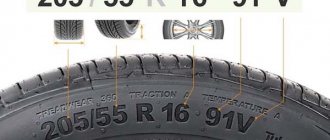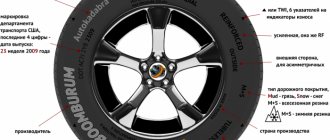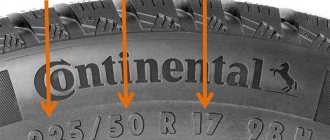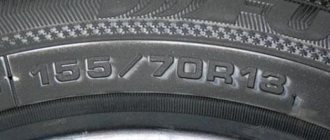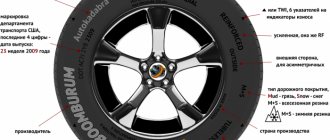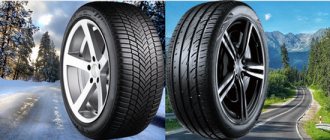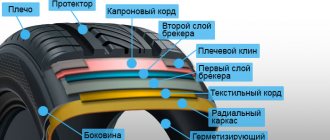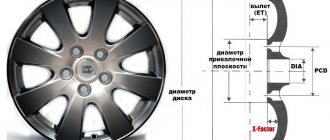Do you want to choose tires for your car, but don’t understand the tire markings? No problem! We hope the information below will help you choose tires of the required size and parameters. You can obtain more complete information from our operators by phone:
(495) 545-29-45
When choosing tires, we first advise you to consult the owner's manual for your vehicle. It contains the markings of tires recommended by the manufacturer. Typically, several standard sizes are indicated depending on the season of use, the disks installed on the machine and the engine size. In our opinion, it is better not to deviate from the recommendations of the car manufacturer and not to install tires of other markings on the car.
If you don’t have the treasured book (manual) at hand, then just go to your car and read what is written on the sidewall of the tire.
Let's take a closer look at the markings using the example of the Hankook Ventus V12 Evo tire:
Typically the size looks like this: 225/45 R17 94Y
Where: 225 – tire width in mm (see figure), 45 – proportionality, i.e. ratio of profile height to width. In this case it is equal to 45%. In short, with the same width, the larger this indicator, the taller the tire will be and vice versa. This value is usually called “profile height”. If this ratio is not indicated (for example 185/R14С) then it is equal to 80-82%.
R – means radial tire. 17 – wheel (disk) diameter in inches.
Speed and load indices
94 – load index. This is the level of the maximum permissible load on the wheel. For passenger cars, it is usually done with a reserve and is not a decisive value when choosing tires; in our case, IN is 94 - 670 kg (see table).
Load index 70 75 80 85 90 95 100 105 110 115 120
Max. Load (in kg.) 335 387 450 515 600 690 800 925 1060 1215 1400
Y – speed index. The larger it is, the higher the speed you can drive on a given tire, in our case IS – Y – up to 300 km/h (see table).
Speed index JKLMNPQRSTUHV VR WY ZR
Max. Speed (km/h) 100 110 120 130 140 150 160 170 180 190 200 210 >240 210 270 300 >240
American tire size designations.
There are two different markings for American tires.
The first is very similar to the European one, only the letters “P” (Passanger - for a passenger car) or “LT” (Light Truck) are placed in front of the standard size. For example: P 195/60 R 14 or LT 235/75 R15.
And another marking, which is fundamentally different from the European one. In our opinion, it is the most incomprehensible for the average consumer.
For example: 31x10.5 R15 (corresponds to European standard size 265/75 R15)
31 is the outer diameter of the tire in inches. 10.5 - tire width in inches. R – radial tire. 15 is the inner diameter of the tire in inches.
Trademark, brand
Product name, model
Country of origin, production
This information indicates the country of manufacture of the tire.
Other information indicated on the sidewall of the tire
An indicator of the degree of wear of the tire tread, upon reaching which the tire should be discontinued. On tires from other manufacturers, the wear indicator may be different from that shown in the photo.
Information about the type of drawing.
Radial - means that it is a radial tire. Tubeless - tubeless tire. If this inscription is absent, the tire can only be used with a tube.
Letter E (circled) - the tire meets the European requirements of ECE (Economic Commission for Europe)
DOT (Department of Transportation - US Department of Transportation) - American quality standard. Encoded manufacturer information.
Rotation and the arrow on the sidewall of the tire indicate a directional tire. When installing the tire, you must strictly observe the direction of rotation of the tire indicated by the arrow.
Max Pressure - maximum permissible tire pressure, in kPa.
Max Load - maximum permissible load on the tire, in kg.
Materials used and number of layers.
The date of manufacture of the tire is written in the form of four digits in an oval, for example 2706 - the first two digits are the week of manufacture, the next two are the year of manufacture, in our example June 2006.
How to find out the speed index on tires?
The speed index, indicated by a letter, is located after the load index on the sidewall of the tire. For example, for a tire with speed index V, the maximum speed is 240 km/h.
Interesting materials:
What mushrooms are purple? What mushrooms can be picked at the beginning of September? What mushrooms turn yellow when cooked? What mushrooms to collect in Crimea? What loads are prohibited from being lowered down the slide? Which foreign cars are reliable? What instruments belong to the string percussion group? What instruments are most often included in a quartet? What corrections are allowed in the TTN? Which sources of artificial lighting are more preferable: incandescent lamps or gas discharge lamps?
Independently determining the year of manufacture of Yokohama tires – it couldn’t be easier
The Yokohama company has been specializing in the manufacture and sale of various types of car tires for almost a century, which are especially popular. In the tire catalog of this brand there are options for drivers of ordinary cars, trucks and sports vehicles, and owners of premium cars.
The tires interact well with different types of roads and are not afraid of dirt and cold. Their service life depends on storage conditions, traffic conditions, and also the production date of the product. The fresher the product, the longer the motorist will use it. When purchasing Yokohama tires, the driver will be able to determine the date of manufacture locally, and if he does not find it, use the Internet. How this is done in both cases is worth considering now.
Determining the date and year of manufacture of automobile tires by DOT code
The International Department of Transportation Safety leaves its marks on all high-quality automotive products, and Yokohama tires belong to this number. If there is a DOT code and other manufacturer information on the side of the tire, and the year of manufacture is missing for some reason, the driver can easily determine it via the Internet.
To find out the year of manufacture of tires for a car by TSA code, do the following:
- enter the search engine and enter the following query - “determining the year of manufacture of Yokohama tires by DOT code”;
- after issuing the address of the desired site, go to it;
- enter the present tire marking symbols in a special line;
- wait for a response from the system.
Within a few minutes the user should receive the information that interests him. If the buyer is not able to independently connect to the World Wide Web and check data on Yokohama products, he should ask the store’s employees for help. They do not have the right to refuse to provide their client with information about the product that interests him.
How to prevent premature aging of rubber
To prevent this detrimental effect, below are practical tips from experienced experts on how to carefully store wheels without using them:
- It is best if each tire is stored in a separate matte bag, then it will be completely protected from the settling of dust and other chemical impurities from the atmosphere, and polyethylene also protects the product from direct sunlight. It also follows that during storage, direct exposure to daylight should be avoided, because ultraviolet radiation destroys some of the binding elements from the tire composition.
- It happens that rubber is stored not as an independent product, but as part of a wheel assembly, and often drivers leave it in this state for the entire season with increased pressure. In this case, it is very important to ensure that this indicator is within the normal range, because excess pressure will lead to stretching of the tire and a gradual weakening of its sole, which causes hernias. And if the wheel is not inflated, then bends, cracks and fractures are possible. In both cases, further operation will be impossible.
- If the tires are worn out, then seasonal re-shoeing of the car will be a good check of their condition, because car enthusiasts have the opportunity to examine them from all sides to determine their further suitability. So, in a situation where a wheel has uneven wear due to a technical malfunction of the suspension or poorly adjusted wheel alignment, the driver will have to take care of purchasing new tires, since further storage and use of the previous ones leads to rupture of the cylinders on the road.
Uneven tire wear
The manufacturing date of tires is a very important detail when purchasing them. Like many other products, rubber compounds are prone to aging. Accordingly, after several years of improper storage from purchasing tires that have never been used before, motorists should abandon the dubious deal, because no manufacturer can guarantee safety due to the loss of most of the performance properties.
*Prices shown are current as of February 2022.
Yokohama tires are one of the most common brands. The service life of rubber is long, but the longer it sits in storage, the shorter it becomes.
Everyone should know how to determine the production time of rubber, and everyone can learn this right now. This information will help you pay exclusively for quality.
Manufacturer
With the advent of more and more new brands, it often becomes difficult for a car enthusiast to make a choice in favor of the only correct solution. In addition, such abundance plays into the hands of all sorts of scammers who, under the guise of a global brand, sell “home-made” low-quality products. To do this, it is extremely important to distinguish a fake from a genuine branded product.
Marking indicating the authenticity of the manufacturer is expressed by the presence of the acronym DOT. In addition, immediately after the presented designation there must be a code of the country of manufacture.
The fact is that most tire manufacturers have many branches located in different parts of the world. Each country of a specific manufacturer is assigned a unique two-digit code. Information about that cipher is not widely distributed. Nevertheless, on some resources you can find a number of articles devoted to deciphering these codes.
Instructions for determining production time
For example, you can take a standard tire from a European brand. Here you can determine the production time in this way.
- Carefully examine the sidewalls of the rubber and find the DOT combination.
- This strip may contain numbers, letters and other symbols.
- You need to move to the end of the line, where you highlight the last 4 digits.
- The first two talk about the week, and the last two talk about the year when the product left the assembly line.
Expert conclusions and recommendations
Expert recommendations will help you choose the right tires and keep them in working condition for a long time.
- The production date of the tire is marked on its sidewall and is a four-digit code in an oval stamp.
- The first two digits of the code indicate the month of manufacture, the next two - the year.
- Even if tires are not used, they wear out and lose their elasticity. This process is accelerated significantly if tires are stored incorrectly.
- Tires in the warehouse should be stored in special plastic bags that protect them from scratches, excessive heat and direct sun.
- The main signs of an “old” tire are small cracks on the sides and a white coating. Driving a car with such tires puts both yourself and your passengers at risk.
- If possible, park your car in the shade, away from the open sun. Taking such care of your car will preserve its color and coating, protect the interior from overheating and delay the aging of rubber.
- Monitor tire pressure. Due to incorrect pressure, the tire overheats and wears out quickly.
- If the tires are worn unevenly on different sides, this is a good reason to go to a service center for a wheel alignment. Simply installing new tires is not the solution; they will also quickly become unusable.
Choose high-quality tires, follow their storage and maintenance conditions - and then they will not let you down.
Source
Where to look for the tire production date among all the designations
As a rule, if you look closely at a new high-quality tire produced by a well-known brand, you can always see a lot of symbols on it, among which it is very easy to get confused, but all the lines are systematized, and their order is repeated regardless of the brand, model and other factors, namely:
- How to determine the production date of a tire? On most of the side cord, as a rule, the name of the company that produced the product is emblazoned with a logo and in a familiar font. Thus, manufacturers often advertise their own products, which are used on any highway.
- The second important indicator that can be seen with the naked eye is the tire size, which consists of 3 parameters - sole width and profile height in mm, as well as the tire size marked R, which means diameter in inches.
- Here, manufacturers often write advantages for use in various road conditions, for example, all-season tires are labeled as M + S, or mud and snow, which translated from English means “dirt” and “snow”. In addition, off-road tires often have the indices NT, HP, AT, MT, indicating the versatility of the wheel.
Prolonged sun exposure to tires
- The second line of markings on the tire, located in close proximity to the place of fixation on the rim of the disk, means less significant parameters required by law - all 5 indices listed above, also the Department of Transportation Security code, product code in the form of the manufacturer's serial number and, finally, the date of manufacture of the product in a 4-digit format, which was decrypted earlier.
Maximum load table
| Index | Weight | Index | Weight | Index | Weight | Index | Weight | Index | Weight |
| 62 | 265 | 75 | 387 | 88 | 560 | 101 | 825 | 114 | 1180 |
| 63 | 272 | 76 | 400 | 89 | 580 | 102 | 850 | 115 | 1215 |
| 64 | 280 | 77 | 412 | 90 | 600 | 103 | 875 | 116 | 1250 |
| 65 | 290 | 78 | 425 | 91 | 615 | 104 | 900 | 117 | 1285 |
| 66 | 300 | 79 | 437 | 92 | 630 | 105 | 925 | 118 | 1320 |
| 67 | 307 | 80 | 450 | 93 | 650 | 106 | 950 | 119 | 1360 |
| 68 | 315 | 81 | 462 | 94 | 670 | 107 | 975 | 120 | 1400 |
| 69 | 325 | 82 | 475 | 95 | 690 | 108 | 1000 | 121 | 1450 |
| 70 | 335 | 83 | 478 | 96 | 710 | 109 | 1030 | 122 | 1500 |
| 71 | 345 | 84 | 500 | 97 | 730 | 110 | 1060 | 123 | 1550 |
| 72 | 355 | 85 | 515 | 98 | 750 | 111 | 1090 | 124 | 1600 |
| 73 | 365 | 86 | 530 | 99 | 775 | 112 | 1120 | 125 | 1650 |
| 74 | 375 | 87 | 545 | 100 | 800 | 113 | 1150 | 126 | 1700 |
This parameter is responsible for the load-carrying capacity of the tire. The tire load index is expressed as a number and is located in the area before the speed indicator.
What causes tires to age?
External factors
The aging process is accelerated by three main factors:
- elevated temperature or frequent temperature changes;
- high humidity;
- exposure to direct sunlight.
It is important to properly store summer and winter tires, protecting them from threatening external factors. By observing storage conditions, you extend the “life” of tires - their elasticity remains at an acceptable level for a long time.
Storage conditions
Tires are quite picky about storage conditions: in order for them to retain their original properties for a long time, they must be stored correctly.
Proper storage is the key to maintaining tire performance
- It is better to keep new tires in plastic bags. They protect the rubber from direct exposure to sunlight and minimize the contact of the tire with the environment.
- The room where tires are stored must be well ventilated. The temperature here is in the range of 0 – 200. In addition, high humidity should not be allowed, otherwise the rubber components will begin to deteriorate.
- Tires cannot be stacked on top of each other. Such storage leads to deformation of tires, which means a decrease in their quality and elasticity.
Storing tires according to the rules is a task that requires control. Consequently, the longer tires remain in storage, the higher the risk that their properties and resources are no longer at that high level.
Quality and initial characteristics of products
The properties of tires, their durability and wear resistance largely depend on the quality of the rubber. Accordingly, they depend on the manufacturer, who selects raw materials for products manufactured under his brand.
Choose tires from proven and well-known manufacturers
The largest companies invest enormous amounts of money in the development of unique compounds - they are added to rubber, making it as resistant to aging as possible.
Not a single method worked - what do these indicators say?
High-quality, original Yokohama car tires always have markings on their sidewalls, which help determine their year of manufacture and find out information about the manufacturer. The motorist can also determine this data using the Transportation Security Department code. If this could not be done using both methods, then we can say that:
- It was not possible to find out the year of manufacture of the tires because they are fake;
- the tires have been damaged in some way and the information on their sidewalls is not displayed correctly;
- The tires have been in storage for many years and therefore it is not possible to determine their year of manufacture.
If these factors are present, you should not buy such tires for your car, because their quality is in question.
High-quality Yokohama products are always labeled and do not stagnate in the warehouses of retail outlets for a long time. If the buyer has questions even about labeled products, they should additionally ask for a certificate confirming the quality. A motorist will be able to determine the year of manufacture of tires in two minutes. When purchasing, you should look at each tire separately, because you cannot be sure that they are from the same batch. The last three or four digits that are present in the total number of marking symbols always indicate the year of manufacture of the product. This standard applies equally to all tire models. If a product has problems with such indicators, it is most likely of poor quality.

